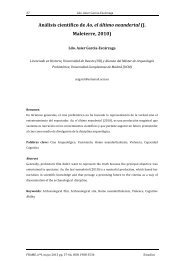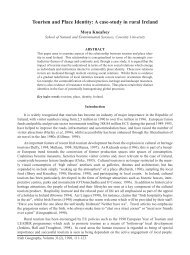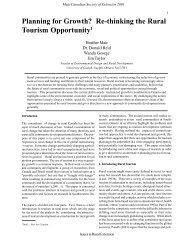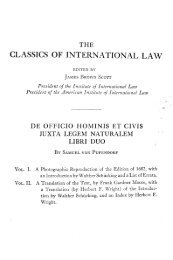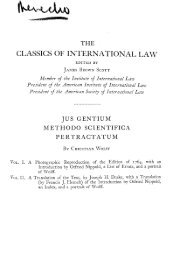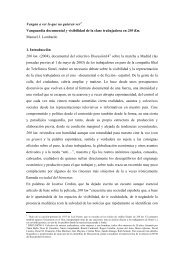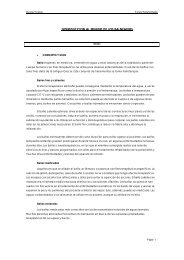Measuring Sustainable Tourism Development in Remote Rural ...
Measuring Sustainable Tourism Development in Remote Rural ...
Measuring Sustainable Tourism Development in Remote Rural ...
You also want an ePaper? Increase the reach of your titles
YUMPU automatically turns print PDFs into web optimized ePapers that Google loves.
Report. This commission, established by the United Nations General Assembly <strong>in</strong><br />
1984, was asked to learn about the connections between the issues of environment<br />
and development. Hence, the term was first used to br<strong>in</strong>g together the apparently<br />
disparate concepts of economic development and environmental conservation. The<br />
Brundtland Report def<strong>in</strong>ed susta<strong>in</strong>able development as:<br />
“<strong>Development</strong> that meets the needs of the present generation without<br />
compromis<strong>in</strong>g the ability of future generations to meet their own needs (p.<br />
43)”<br />
Real community development must <strong>in</strong>clude physical development with people<br />
development; economic development with political development; <strong>in</strong>creas<strong>in</strong>g a<br />
community’s capacity for tak<strong>in</strong>g control of its own development. For this to occur, each<br />
at its own pace, an evolv<strong>in</strong>g process is necessary for build<strong>in</strong>g with<strong>in</strong> the community the<br />
ability for critical th<strong>in</strong>k<strong>in</strong>g and plann<strong>in</strong>g with an <strong>in</strong>creased capacity to meet future needs.<br />
Experience has provided some clear lessons about what works and what does not<br />
work <strong>in</strong> community- based development. Prom<strong>in</strong>ent among the failures has been<br />
attempts to achieve results on a wide scale through the <strong>in</strong>fusion of external<br />
management, funds, and technology, controlled from distant places.<br />
A fundamental prerequisite of successful participatory programs at the community level<br />
is the reversal of control and accountability from central authorities to the community<br />
level; and, when the success of projects depends heavily on changes <strong>in</strong> behaviour at<br />
the community level, promot<strong>in</strong>g participation <strong>in</strong> community-based programs may be the<br />
only means of meet<strong>in</strong>g objectives (World Bank, 1998). It is up to <strong>in</strong>dividual<br />
communities to determ<strong>in</strong>e how they want to balance the status quo with the benefits of<br />
growth, and how effective they are go<strong>in</strong>g to be <strong>in</strong> mitigat<strong>in</strong>g the negative effects they<br />
want to avoid. In order to achieve these ends, new techniques to supplement and <strong>in</strong><br />
some cases replace the traditional methods of land use control are required (Scott,<br />
Brower and M<strong>in</strong>er, 1975).<br />
It is suggested that the plann<strong>in</strong>g process needs to <strong>in</strong>volve those people who live, work,<br />
own property, or own bus<strong>in</strong>esses <strong>in</strong> the community and <strong>in</strong>cludes the organisations and<br />
<strong>in</strong>stitutions <strong>in</strong> the plann<strong>in</strong>g process. This bottom-up approach empowers communities<br />
through local actors, i.e. people’s organisations, for creat<strong>in</strong>g important sources of<br />
action at the local level with a strong <strong>in</strong>terest for promot<strong>in</strong>g susta<strong>in</strong>able livelihood. In<br />
other words, it needs to <strong>in</strong>clude the local residents and the local stakeholders work<strong>in</strong>g<br />
together to promote mutual responsibility and jo<strong>in</strong>t problem solv<strong>in</strong>g.<br />
In establish<strong>in</strong>g and promot<strong>in</strong>g grass-roots mechanisms, capacity-build<strong>in</strong>g and<br />
empowerment, we are <strong>in</strong>duc<strong>in</strong>g a community-driven approach to susta<strong>in</strong>able<br />
development. In this context it is critical to view community economic development as a<br />
long-term process that fuses community control and direction with specific tools and<br />
outcomes (Zdenek, 1987). Empowerment does not so much mean grant<strong>in</strong>g or<br />
transferr<strong>in</strong>g power as it does <strong>in</strong>creas<strong>in</strong>g civic awareness of the efficacy of democratic<br />
<strong>in</strong>volvement, through self-respect, mutual esteem, capacity-build<strong>in</strong>g, genu<strong>in</strong>e<br />
responsiveness and open accountability (Schwer<strong>in</strong>, 1995). The diverse members of<br />
the community should be represented <strong>in</strong> order to, more appropriately, identify the<br />
community´s strengths and assets, needs and concerns; establish goals for<br />
community development; provide recommendations for how to reach those goals; and,<br />
<strong>in</strong>fluence, or possibly direct, the policy and f<strong>in</strong>ancial decisions of local decision-makers.



